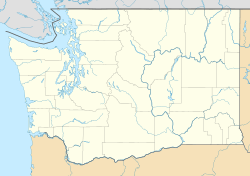Fort Ward (Washington) facts for kids
Quick facts for kids |
|
|
Fort Ward Historic District
|
|

Battery Vinton, 2013
|
|
| Nearest city | Bainbridge Island, Washington |
|---|---|
| Area | 166 acres (67 ha) |
| NRHP reference No. | 78002759 96000415 (boundary increase) |
| Added to NRHP | January 12, 1978 April 12, 1996 (boundary increase) |
Fort Ward was once an important United States Army fort. It was built to protect the coast with large guns. Later, it became a Navy base. You can find it on the southwest side of Bainbridge Island, Washington, right next to Rich Passage.
Contents
History of Fort Ward
Building the Fort
In the 1880s, a group of military experts called the Endicott Board suggested new ways to defend America's coastlines. They realized that big, fixed guns needed different training than smaller, moving guns.
Fort Ward started as a place called Beans Point in 1890. It was one of several forts built by the US Army to protect Puget Sound from enemy ships. Its main job was to guard the important Bremerton Naval Shipyard nearby.
In 1903, the Army officially named Beans Point "Fort Ward." This honored Colonel George H. Ward. More buildings were added, and new soldiers arrived at the fort.
Coastal Guns at Fort Ward
Fort Ward had several large gun batteries. These were places where big guns were set up to fire at ships. They included:
- Battery Nash (1903–1918): This battery had three 8-inch guns that could disappear into the ground. They were hidden along the bluff.
- Battery Warner (1903–1925): This battery had two 5-inch guns mounted on tall pillars.
- Battery Thornburgh (1903–1920): This battery had four 3-inch guns hidden behind a low wall.
- Battery Vinton (1903–1920): This battery had two 3-inch guns, also hidden behind a low wall.
Battery Vinton, like the other batteries, helped guard an underwater minefield. This minefield was placed across Rich Passage to stop enemy ships. The guns were taken away on July 19, 1920. They were never fired in defense. They were meant to be sent to France for use in World War I.
In the 1920s, Fort Ward was not used as much. Only a few soldiers stayed there. By 1928, the fort was mostly empty. For a few years around 1935, it was even used as a summer camp for children from Seattle.
Fort Ward in World War II
In 1938, the U.S. Navy took over Fort Ward from the Army. The Navy found that the fort was a great place to listen to radio messages from far away, especially from Japan. In August 1939, the Navy moved its listening station from Astoria, Oregon, to Fort Ward. This was the start of Fort Ward becoming a top-secret listening post.
By August 1940, the U.S. Navy had five main listening sites. These sites were connected to Washington, D.C., by radio and landlines. Fort Ward was one of these important locations.
Large radio antennas were set up on the Parade Ground. The old gym building became a secret listening post called "Station S". Inside "Station S", Navy personnel worked day and night. They listened to secret messages from the Japanese Navy. These messages were sent using Japanese Morse Code. Today, this building is a private home.
The work at "Station S" was so secret that people on the base were told not to even look at the building when they walked by.
The Navy created a "cover story" for Fort Ward. They said it was a radio training school for Navy reservists. This story even appeared in The Seattle Times newspaper in January 1941. Some sailors in the newspaper photos actually worked at "Station S" after their training.
In March 1941, a special teletype line was set up. It connected Fort Ward to other important listening stations. Sending secret messages was still difficult. Officers had to use special equipment to encode messages. Fort Ward also oversaw the building of the Navy's largest radio transmitter at Battle Point. This huge tower was used to send messages to Navy Command in Seattle.
Fort Ward played a key role just before the attack on Pearl Harbor. "Station S" intercepted a message from Tokyo to the Japanese Ambassador. This message told him to stop talks with the U.S. government. This happened right before the attack on December 7, 1941.
During World War II, a large submarine net was placed across Rich Passage. This net helped protect the area from enemy submarines.
In November 1942, Fort Ward also took over some intelligence tasks from the Royal Canadian Navy.
After World War II, the base was given back to the U.S. Army in 1956. Personnel continued to listen to radio messages, first from Korea, then from the Soviet Union. This activity continued until 1956.
After World War II
The U.S. Army stopped all operations at Fort Ward in 1958. After it closed, the Washington State Park System bought part of the fort in 1960. This area became Fort Ward State Park. In 2011, it was transferred to the Bainbridge Island Metro Park & Recreation District and became Fort Ward Park.
The large Navy radio transmitting station at Battle Point was closed on March 31, 1959. Its equipment was removed in 1971. That location is now Battle Point Park.
Over the years, some of the old fort buildings have been turned into homes. The area where the fort was, known as Fort Ward, is now a National Historic Site. Many of the homes there are also listed on Bainbridge Island's Historic Register.


